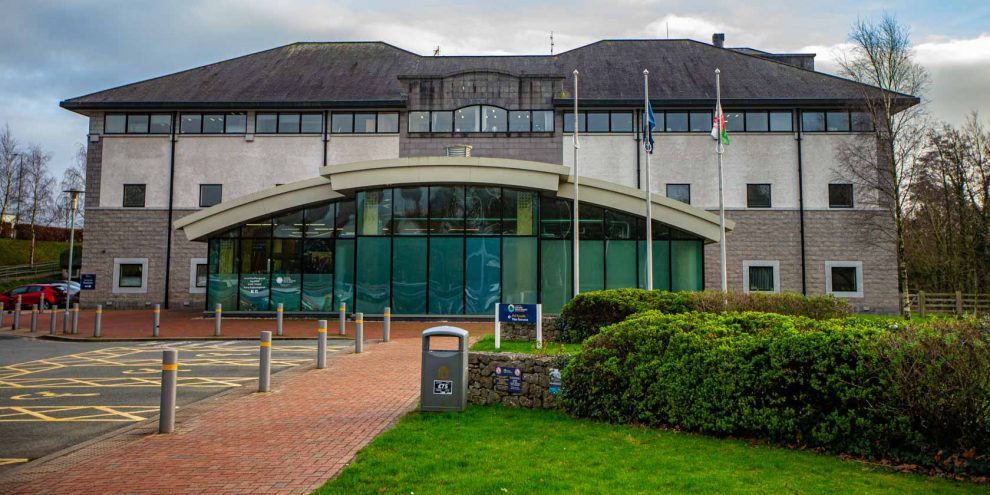MONUMENTAL archaeological features of “national significance” and humble items of everyday life have been uncovered during work to develop six flats in Beaumaris.
A lost medieval defensive wall and ditch – built in the era of Owain Glyndwr – and scores of artefacts describing Anglesey life over hundreds of years have been recovered from Steeple Lane.
They came to light during archaeological work amid a development by Anglesey County Council on the site of the former Sports and Social Club.
The full extent of the finds have been revealed in an archaeological report by CR Archaeology, within a council planning document posted this week.
The scheme to provide “affordable homes” gave archaeologists a rare chance to probe the town’s hidden history.
Historically important remains of the once imposing town’s defensive wall and the town ditch both dating from the early 1400s have been revealed.
The stretch of wall had previously been identified by the Royal Commission on the Ancient and Historical Monuments of Wales RCAHMW and appeared on a 1937 plan.
According to a report by CR Archaeology for Anglesey County Council, the wall had been designated as a scheduled monument.
However the report states, it was “erroneously believed to have been destroyed by the 1970’s extension to the social club and was de-scheduled.”
Now, following the recording of the wall, the section has been made safe and is now being considered for re -scheduling.
Smaller finds from various periods including items of domestic and trade waste, animal bones, medieval pottery, tile sherds, glass and ceramic bottles, stone pot lids, sharpening and burnishing stones, and even a Sunlight Soap metal advertising sign have also been uncovered.
The town ditch, was found to have survived beneath the road frontage, was identified following the demolition of Steeple Lane properties. Upper fills had been excavated and found to contain material of 17th-18th century date.
A number of 19th – early 20th century bottles and jars collected from the area at the rear of the social club has also provided evidence of the town’s strong trading links between Beaumaris, the rest of Wales and places like Liverpool.
Later nineteenth-earlier twentieth century material, mainly bottles but, including items such as glass medicine bottles and stoneware jam jars were also recovered.
One clear green glass codd-neck bottle with its surviving marble, has the raised letters ‘THE PIER, MINERAL WATER Co, BANGOR,’ and dated between 1866-1913. On the back is ‘CANNINGTON SHAW & CO LTD, MAKER, ST HELENS’
Others included a Ruthin Soda Water Co, in blue-green glass, a Torpedo bottle, dated 1857 – 1900, 19th century Schofield Bros bottles from Liverpool and a Jewsbury & Brown Bottle, a clear green bottle, from Manchester, 1890 – 1920.
According to a report by CR Archaeologists, for the council, the area west of the town wall was commonly referred to as Clay Pitts, later Clay Pits.
It describes how the area was once home to ‘dirty’ manufacturing trades such as tanning, leather working and brick making/clay digging for brick manufacture..
Items relating to the notoriously smelly process of leather tanning suggest that the part of town was likely to be a poorer area.
According to the report, documents in the Anglesey Archive also showed a higher number of poor rate payments made between 1786 -1799 for properties in the Clay Pitts area..
The town ditch remains have also provided an intriguing insight into the role of animals within the town.
And bones showing butchery marks have also given clues to what people were eating, including mutton, beef, pork, and chicken, with the occasional addition of venison, and mollusc and oyster shells suggested a seafood was on the menu.
Numerous animal bones from cattle to sheep, goats, roe deer, chickens, foxes, swans and geese, dogs and cats – although not all were considered food waste.
An usually large number of dog remains have also been found. Curiously six dogs and a cat were all in one area of the ditch fill together.
“It is possible that the dogs and cat in the Beaumaris town ditch include the remains of stray animals that were destroyed as a result of their nuisance in the town, and discarded in the town ditch as a means of disposal,” The reports suggests.
The report also notes there were no horse bone remains, stating, “the consumption of horse meat during the 17th-18th century in Wales is not yet well understood, but it is certain that the primary function of horses during this period was transportation of people and goods, rather than meat production.”
Medieval material, with decorated tile fragments dating from the 13th to the 15th century were also removed from the town ditch.
There is a suggestion that some of the fragments may have come from the Franciscan friary in Llanfaes founded 1237 and some from the nearby St Mary’s and St Nicholas Church which was founded in 1330 and remodelled several times.
Jenny Emmett Senior Planning Archaeologist for Gwynedd Archaeological Trust said:
“What has been really interesting in this project has been the contrast between what we have learned about the town, and its town ditch and wall, which was a monumental feature associated with the town’s medieval defences.
“What has been interesting is the contrast between the monumental medieval defences and the smaller, more humble artefacts that tell the fascinating stories of ordinary Beaumaris folk.
“But finding an up-standing piece of the wall has really been one of the most exciting discoveries.
“It has now been restored by specialists and people will be able to see it, as it is now incorporate within part of the wall in the car on Steeple Lane, and it is now being considered for rescheduling.”
She added that it had been a “complex site to manage” but that there had been “good team work” between the archaeologists and the council and it has been “sensitively handled.”
To see the report in full: see: – DIS/2023/64 Within an application to discharge condition (05) (Archaeological) of planning permission CAC/2019/3 (Conservation Area consent for the demolition of the existing building together with the erection of six one bedroom flats in lieu) in the Anglesey County Council planning documents.

















